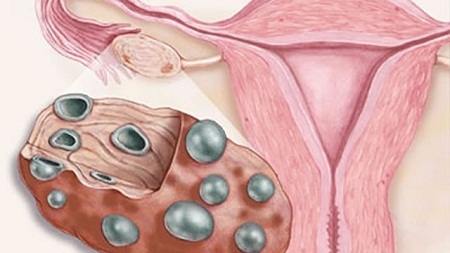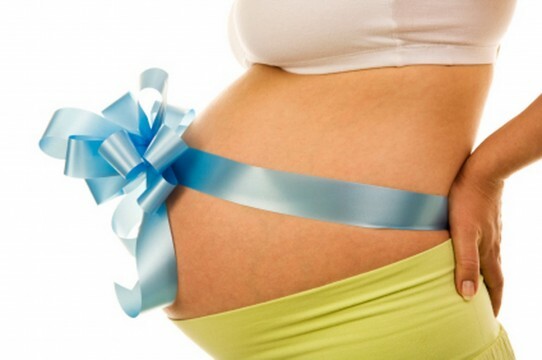Polycystic ovary is not a disease, but a clinical syndrome caused by chronic disruption of the ovaries and endocrine glands - pancreas, adrenal glands, pituitary gland and hypothalamus. Currently, polycystic ovary and pregnancy are completely compatible. A competent and attentive gynecologist, after an accurate diagnosis of the causes of polycystic ovary, can help women overcome difficulties with conceiving, bearing and giving birth to a child.
Diagnosis of "Ovarian cyst" in terms of the onset and course of pregnancy, in most cases, is not so severe.
Polycystic syndrome

How to become pregnant with polycystic ovaries? If you really have this diagnosis, do not be surprised and get ready for the next treatment regimen. To begin with, needs to restore not only the regularity of menstrual cycles, but also achieve ovulation by the following actions:
- Regular exercise - long walks and pilates;
- Observance of low-calorie diet and rejection of bad habits;
- Taking tablets Metformin and / or one of the glitazone preparations - Pioglitazone or rosiglitazone;
- Drugs with myo-inositol - Inositol, Inofert, D-ciro.
Only after the exact hormonal studies the doctor will designate something from the list below:
- preparations suppressing the production of androgens - Spironolactone, Veroshpiron, Tsiprateron, Diane-35;
- endogen-containing drugs( for restoring menstruation) - Levonorgestrel, Ethinyl estradiol, Miniziston;
- dosage forms from the progestin series - Progestin, Duphaston, Progesterone, Urozhestan;
- in a small dosage in the evening - Dexamethasone.
For individual indications, the doctor may prescribe Bromocriptil or L-thyroxine.
In the event that after a long reception of Metformin ovulation is not restored, in addition to it or a special scheme, the following stimulants are prescribed:
- Klostilbegit;
- Clomid;
- Serofen;
- Tamoxifen;
- Fariston;
- Reloxifene.
After the course of treatment, most of the preparations will be canceled before the planned conception. In their place will be put other means, the active substances of which and their dosages will vary depending on the trimester of pregnancy, the state of health of the future mother and the testimony of hormonal background analysis.
With such a diagnosis, one should not hope for complete cancellation of preparations of various kinds, otherwise the threat of miscarriage, fetal fading and / or defects in his development, gestational diabetes, a sharp set of body weight and premature birth are imminent.
If medication did not lead to fertilization, despair is not necessary! Modern surgical methods of neoplasm removal will come to the rescue:
- laparoscopy;
- laser operation or diathermocoagulation;
- decapsulation or partial resection.
After surgery, the polycystosis will not bother from 6 to 12 months, during which it is realistic to get pregnant. But in this case, immediately after successful fertilization, drug maintenance therapy is needed throughout the pregnancy.
Ovarian cyst

Many young women are tormented by the question: Can I get pregnant with an ovarian cyst? The answer is ambiguous - any ovarian cyst with due regard to it does not interfere with the normal development of pregnancy and childbirth , but some types of cyst may become pregnant with pregnancy. The obstacle will not be the cyst itself, but the root cause of its occurrence. However, at the present time, such reasons can be successfully balanced by modern hormonal drugs or cyst removal.
Follicular and yellow body cysts are functional, occur in all women periodically, are not an obstacle to the onset of pregnancy and do not have a detrimental effect on its development. On the contrary, a natural change in the hormonal background contributes to their rapid resolution and by the end of the first trimester they will disappear by themselves. If fertilization does not occur, then it is already a question of the polycystic ovary syndrome and requires appropriate tests and therapy.
The presence of dermoid cysts is dangerous for pregnancy only in terms of its possible growth( against the background of a changed hormonal background in the body of a pregnant woman), twisting the leg or rupture during fetal growth. Resection of such a cyst may not be required.
The paravarian, chocolate or hormone-producing cysts result from persistent hormonal abnormalities that can impede the onset of ovulation. But if the fertilization does happen, the cysts require close attention and, as a rule, are surgically removed in the first trimester, with the subsequent hormonal accompaniment of the entire pregnancy( right up until the birth).
Cyst resection and ovulation
If a woman has one ovary, pregnancy is possible.
Practicing gynecologists statistically note that the right ovary has more physiological activity than the left one, as leads to more frequent cysts on the right side of the .Even if the pathology of the right ovary led to its complete removal, the left one remains. Of course, it does not begin to work 2 times more often, but with a normal hormonal background and the presence of ovulation, 1 time in 2-3 months is likely the onset of pregnancy.



